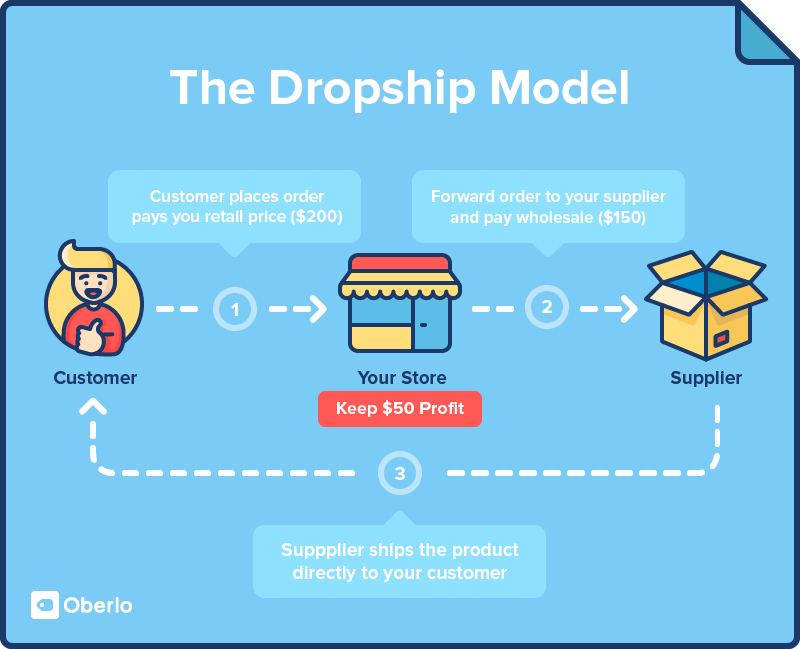The Pros & Cons of Dropshipping
Dropshipping as a business model has become very popular among online sellers and entrepreneurs alike. It is a shipping and fulfillment method in which the online retailer does not actually stock its inventory. When defining the term, it is important to highlight the three parties involved in the dropshipping process:
- The dropshipping supplier
- The seller/retailer (you)
- The Customer
Once the customer purchases the product from the seller’s online store, the seller notifies and pays the dropshipping supplier, either manually or automatically, and the supplier packs the item and ships it directly to the customer. As the products are stocked, packed and sent to the customer by the supplier, the seller does not need a warehouse to hold such products.

While starting your own online dropshipping store is a fairly simple process, it is important to weigh up the pros and cons of running a dropshipping business before you get started. Let’s look at some of the advantages of running a dropshipping store as opposed to a traditional store.
Pros
Opening an online dropshipping store is cheap and involves little financial risk
With dropshipping, you don’t need to spend your money on buying or manufacturing a product inventory. Aside from building your online store and buying a domain name along with hosting, you only start spending money after you make an actual sale. Selling a product means you then have to purchase the product from the supplier, preferably using part of the payment you received from the customer. Dropshipping completely changes the supply chain process, excluding costly shackles (freight services, port operations, storage, warehouse employees, packaging and labeling).
Dropshipping offers store owners great flexibility
As opposed to selling your own physical inventory in a brick and mortar shop or online store, dropshipping gives you the option to run your business from anywhere – the only requirement is a working internet connection. You do not need to handle any of the products you sell, nor do you need to rent a warehouse or storage space that ties to you one location. You can manage your store from your living room, from the train, a cafe – even from the jacuzzi in your holiday cabin if you wanted to.
Dropshipping stores can offer a wide, almost unlimited variety of products
Since you’re selling other manufacturers’ products, you are able to offer virtually any product you think is suitable, as long as it fits your store’s product offer and general direction. The top dropshipping supplier directories house a wide range of manufacturers, each specializing in a variety of niches, making it simple for you to expand the products offered on your site.

Dropshipping allows for live testing
If you’re thinking of expanding into another product category, you can just go ahead and do it, and promote those products in the online store. If unsuccessful, you can delete the products in a matter of seconds.
Dropshipping leaves time for store development
Not having to deal with product manufacturing, order picking and handling, distribution, packaging, and such, dropshippers save precious time that they can invest in improving their online store’s design and layout, providing quality Customer Service, and think of creative ways to brand and market their business.
Obviously, there is another side to dropshipping. It is popular, but if it would have only upsides and no downsides, everybody would be dropshipping. This is not the case. Before you open your dropshipping store, make sure you are aware of and can plan for the following:
Cons
Building up a good reputation is hard, acquiring a bad reputation is easy
Since you are not responsible for the order fulfillment of purchases made in your store, you are dependent on the supplier to handle this very important task. While completely out of your hands, adequate and especially inadequate order fulfillment rubs off on your store’s reputation. It is of the utmost importance to find reliable suppliers that do a quality job when it comes to order fulfillment. The companies featured in dropshipping supplier directories such as Inventory Source and Oberlo are carefully vetted to ensure they are trustworthy and offer a high-quality service.
Even without physical inventory, the store’s virtual inventory needs to be managed and updated
This can be done manually, but there are options for dropshipping stores to automate their inventory management in cooperation with the supplier. It’s important to prevent offering out of stock products and keep close track of the availability of offered products.
Getting your store ranked in search engines takes time and SEO expertise
Your store cannot be successful if your potential customers cannot find it online. There are several ways of getting your brand noticed, one of which is SEO, which is the expertise of getting your store ranked in Google and other search engines. Good SEO management takes time and persistence.
While order fulfillment is not your task, customer service is
Your reputation stands or falls with the way you handle problems with shipments, returns, et cetera. There is no such thing as a flawless supplier; you need to be ready to assist your clientele with the best service possible. Anything less than that results in a blemished reputation.
Creating a style/ visual language for your store
Not everybody is a designer. While there are plenty of platforms that provide toolsets to build your own online store, it does not mean the outcome of such an effort is attractive enough to draw visitors. Additional investments may have to be made. eCommerce platforms such as Shopify and Volusion offer professionally designed templates to overcome this issue.

The possibility of minimized profit margins due to high competition lies lurking
In highly competitive fields, you may be forced to drop your prices to be able to sell anything, leaving little profit margin. Until your store has the necessary brand value to sell itself, you may be forced to deal with competitive pricing. Another option is to find a less competitive niche to target.





